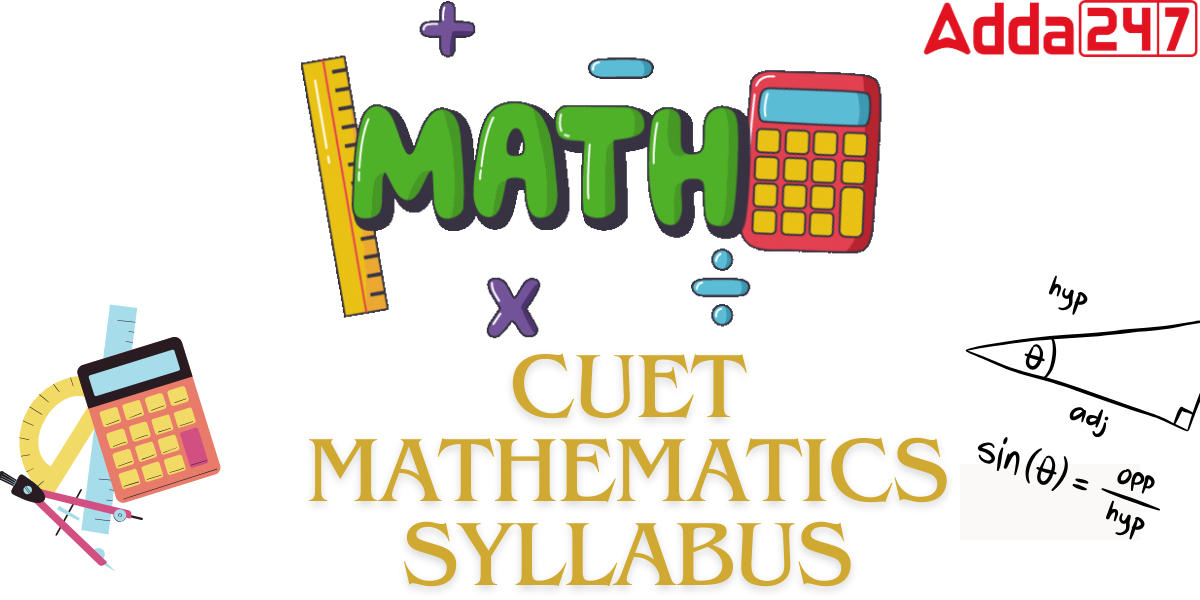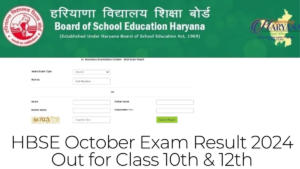Table of Contents
The National Testing Agency publishes the CUET Maths Syllabus 2025 for the Common University Entrance Test for Undergraduates (CUET UG). Candidates can check and download the CUET Mathematics Syllabus from the official website of CUET i,e, cuet.samarth.ac.in. On this page, you can also get the same CUET Maths Syllabus PDF. All of the units that would be covered in the CUET Maths exam are defined and described in the CUET Mathematics syllabus.
CUET Maths Syllabus 2025
To secure good marks and pursue your higher studies in mathematics at your dream college, all you need is a good understanding of the CUET Mathematics Syllabus and practice. Math requires practice, practice, and practice. The more you revise, the more you clear your concepts.
The CUET Maths Syllabus 2025 is quite lengthy, but if you plan your CUET math preparation in an effective way, you will definitely achieve good marks. Candidates are advised to go through the entire CUET Maths Syllabus o ensure that no topic is missed in their CUET Preparation.
CUET UG Maths Exam Pattern 2025
The Common University Entrance Test (CUET)is held for students seeking admission to Central Universities for undergraduate programmes. The CUET Maths Exam is divided into three sections. Sections 1A and 1B sections include General and Special Languages, Section II – 27 Domain-specific Subjects, and Section III – General Test.
The Section II of the CUET 2025 includes tests on all the domain-specific subjects. Section II includes the Mathematics domain. Mathematics question papers contain 85 questions, with 65 of them to be answered. The Mathematics exam is worth 325 marks. The following table includes the key details of the CUET Mathematics Exam and its Exam pattern.
CUET UG Maths Exam Syllabus: Overview
| CUET UG Maths Syllabus | |
| Exam conducting body | National Testing Agency |
| Examination Name | Common Universities Entrance Test (CUET UG) |
| Medium of Examination | 13 Languages (English, Kannada, Hindi, Punjabi, Marathi, Tamil, Urdu, Malayalam Odia, Assamese Telugu, Bengali and Gujarati ) |
| Examination Mode | Computer-based Test (CBT) |
| Time allotted for Maths Exam | 45 minutes |
| Total number of questions in the Maths section | 85questions |
|
Total number of Questions to be Answered in Mathematics
|
65 questions
|
|
Total marks in Mathematics
|
325
|
| Marking Scheme | Marks per correct answer: +5 Marks per the wrong answer: -1 Marks per unanswered questions: 0 |
Maths CUET Syllabus Unit Wise
The CUET Maths Syllabus 2025 is initially broken down in Two Sections, Section A and Section B. Section A will have 15 questions covering both i.e. Mathematics/Applied Mathematics which will be compulsory for all candidates.
Section B of the Math Question Paper will contain Two Sections i.e. Section B1 and B2. Section B1 will have 35 questions from Mathematics out of which 25 questions need to be attempted. Section B2 will have 35 questions purely from Applied Mathematics out of which 25 question will be attempted.
| CUET Maths Syllabus & Question Distribution | ||
| Sections | Total number of questions | Total number of Questions must be Answered |
| Section A | 15 questions | 15 questions |
| Section B | ||
| Section B1 | 35 questions | 25 questions |
| Section B2 | 35 questions | 25 questions |
CUET Maths Syllabus 2025 Section A (Applied Maths)
The Section A of CUET Mathematics Syllabus 2025 is divided in to several subsections. There are a total of 15 questions in section A of the mathematics exam. These 15 questions must be answered by the contestant. The exam includes problems from both mathematics and applied mathematics. The topics are included in the CUET Mathematics Section A given below:
CUET Maths Section A
- Algebra-
(i) Matrices and types of Matrices
(ii) Equality of Matrices, transpose of a Matrix, Symmetric and Skew Symmetric Matrix
(iii) Algebra of Matrices
(iv) Determinants
(v) Inverse of a Matrix
(vi) Solving of simultaneous equations using Matrix Method
2. Calculus
(i) Higher order derivatives
(ii) Tangents and Normals
(iii) Increasing and Decreasing Functions
(iv). Maxima and Minima
3. Integration and its Applications-
(i) Indefinite integrals of simple functions
(ii) Evaluation of indefinite integrals
(iii) Definite Integrals
(iv) Application of Integration as area under the curve
4. Differential Equations
(i) Order and degree of differential equations
(ii) Formulating and solving of differential equations with variable separable
5. Probability Distributions
(i) Random variables and their probability distribution
(ii) Expected value of a random variable
(iii) Variance and Standard Deviation of a random variable
(iv) Binomial Distribution
6. Linear Programming
(i) Mathematical formulation of Linear Programming Problem
(ii) Graphical method of solution for problems in two variables
(iii) Feasible and infeasible regions
(iv) Optimal feasible solution
Maths CUET Syllabus 2025 Section B
The Section B of the CUET mathematics Syllabus divided into 2 parts: B1 and B2. There are 35 questions in Section B1 related to mathematics. The contestant must respond to 25 questions. There are 35 questions in Section B2 from applied . The candidate is required to answer 25 questions. Go through both the Section B1 and B2 of CUET Mathematics Syllabus 2025 in detailed manner.
CUET Maths Section B1
UNIT 1: RELATIONS AND FUNCTIONS
1. Relations and Functions: Types of relations: Reflexive, symmetric, transitive, and equivalence relations.One-to-one and onto functions, composite functions, the inverse of a function.Binary operations.
2. Inverse Trigonometric Functions: Definition, range, domain, principal value branches. Graphs of inverse trigonometric functions. Elementary properties of inverse trigonometric functions.
UNIT II: ALGEBRA
1. Matrices: Concept, notation, order, equality, types of matrices, zero matrices, transpose of a matrix, symmetric and skew-symmetric matrices.Addition, multiplication, and scalar multiplication of matrices, simple properties of addition, multiplication, and scalar multiplication. Non-commutativity of multiplication of matrices and existence of non-zero matrices whose product is the zero matrices (restrict to square matrices of order 2). Concept of elementary row and column operations. Invertible matrices and proof of the uniqueness of inverse, if it exists;(Here all matrices will have real entries).
2. Determinants
Determinant of a square matrix (upto3×3matrices), properties of determinants, minors, cofactors, and applications of determinants in finding the area of a triangle. Adjoint and inverse of a square matrix. Consistency, inconsistency, and number of solutions of the system of linear equations by examples, solving a system of linear equations in two or three variables (having unique solution) using the inverse of a matrix.
UNIT III: CALCULUS
1. Continuity and Differentiability: Continuity and differentiability, a derivative of composite functions, chain rules, derivatives of inverse trigonometric functions, derivative of implicit functions.Conceptsofexponential, logarithmic functions. Derivatives of log x and ex. Logarithmic differentiation.Derivative functions expressed in parametric forms. Second-order derivatives.Rolle’s and Lagrange’s Mean Value Theorems (without proof) and their geometric interpretations.
2. Applications of Derivatives
Applications of derivatives: Rate of change, increasing/decreasing functions, tangents and normals, approximation, maxima, and minima(first derivatives motivated geometrically and second derivative test given as a provable tool).Simple problems(that illustrate basic principles and understanding of the subject as well as real-life situations). Tangent and Normal.
3. Integrals
Integration as inverse process of differentiation.Integration of a variety of functions by substitution, by partial fractions, and by parts, only simple integrals of the type –

4. Applications of the Integrals
Applications in finding the area under simple curves, especially lines, arcs of circles /parabolas /ellipses (in standard form only), and area between the two above said curves (the region should be clearly identifiable).
5. DifferentialEquations
Definition, order and degree, general and particular solutions of a differential equation. Formation of differential equation whose general solution is given. Solution of differential equations by the method of separation of variables, homogeneous differential equations of first order and first degree. Solutions of linear differential equation of the type –

UNIT IV: vectors and Three dimensional Geometry
1. Vectors
Vectors and scalars,magnitude and direction of a vector. Direction cosines/ratios of vectors.Types of vectors (equal, unit, zero, parallel and collinear vectors), position vector of a point, negative of a vector, components of a vector, addition of vectors, multiplication of a vector by a scalar, position vector of a point dividing a line segment in a given ratio. Scalar(dot) product of vectors, projection of a vector on a line. Vector (cross) product of vectors, scalartriple product.
2. Three-dimensional Geometry
Direction cosines/ratios of a line joining two points. Cartesian and vector equation of a line, coplanar and skewlines,shortest distance between two lines.Cartesian and vector equation of a plane.Angle between (i)two lines, (ii)two planes, (iii) a line and a plane. Distance of a pointfroma plane.
UNIT V: LinearProgramming
Introduction, related terminology such as constraints, objective function, optimization, differenttypes of linear programming (L.P.) problems, mathematical formulation of L.P. problems, graphical method of solution for problemsin two variables, feasible and infeasible regions, feasible and infeasible solutions,optimalfeasiblesolutions(uptothreenon-trivial constrains).
Unit VI: Probability
Multiplications theorem on probability.Conditional probability, independent events, total probability, Baye’stheorem. Random variable and its probability distribution, mean and variance of haphazard variable.Repeated independent (Bernoulli) trials and Binomial distribution.
CUET Mathematics Syllabus Section B2
Unit I : Numbers, Quantification and Numerical Applications
- Modulo Arithmetic
•Define modulus of an integer
•Apply arithmetic operations using modular arithmetic rules - Congruence Modulo
•Define congruence modulo
•Apply the definition in various problems - Allegation and Mixture
•Understand the rule of allegation to produce a mixture at a given price
•Determine the mean price of a mixture
•Apply rule of allegation - Numerical Problems
•Solve real life problems mathematically - Boats and Streams
•Distinguish between up stream and downstream
•Express the problem in the form of an equation - Pipes and Cisterns
•Determine the time taken by two or more pipes to fill or - Races and Games
•Compare the performance of two players w.r.t. time, distance taken/distance covered/ Work done from the given data. - Partnership
•Differentiate between active partner and sleeping partner
•Determine the gain or loss to be divided among the partners in the ratio of their investment
with due
•Consideration of the time volume/surface area for solid formed using two or more shapes - Numerical Inequalities
•Describe the basic concepts of numerical inequalities
•Understand and write numerical in equalities
Unit II: ALGEBRA
- Matrices and types of matrices
•Define matrix
•Identify different kinds of matrices - Equality of matrices, Transpose of a matrix, Symmetric and Skew symmetric matrix
•Determine equality of two matrices
•Write transpose of given matrix
•Define symmetric and skew symmetric matrix
UNIT III: CALCULUS
- Higher Order Derivatives
•Determine second and higher order derivatives
•Understand differentiation of parametric functions and implicit functions Identify dependent and independent variables - Marginal Cost and Marginal Revenue using derivatives
•Define marginal cost and marginal revenue
•Find marginal cost and marginal revenue - Maxima and Minima
•Determine critical points of the function
•Find the point(s) of local maxima and local minima and corresponding local maximum and local minimum values
•Find the absolute maximum and absolute minimum value of a function
UNIT IV: PROBABILITY DISTRIBUTIONS
- Probability Distribution
• Understand the concept of Random Variables and its Probability Distributions
• Find probability distribution of discrete random variable - Mathematical Expectation
• Apply arithmetic mean of frequency distribution to find the expected value of a random
variable - Variance
• Calculate the Variance and S.D. of a random variable
UNIT V: Index Numbers and Time based Data
- Index Numbers
•Define Index numbers as a special type of average - Construction of Index numbers
• Construct different type of index numbers - Test of Adequacy of Index Numbers
• Apply time reversal test
UNIT V: INDEX NUMBERS AND TIME BASED DATA
- Population and Sample
•Define Population and Sample
• Differentiate between population and sample
• Define a representative sample from a population
- Parameter and Statistics and Statistical Interferences
• Define Parameter with reference to Population
• Define Statistics with reference to Sample
• Explain the relation between Parameter and Statistic
• Explain the limitation of Statistic to generalize the estimation for population
• Interpret the concept of Statistical Significance and Statistical Inferences
• State Central Limit Theorem
• Explain the relation between Population-Sampling Distribution-Sample
UNIT VII: INDEX NUMBERS AND TIME-BASED DATA
- Time Series
• Identify time series as chronological data - Components of Time Series
• Distinguish between different components of time series - Time Series analysis for univariate data
• Solve practical problems based on statistical data and Interpret
UNIT VIII: FINANCIAL MATHEMATICS
- Perpetuity, Sinking Funds
• Explain the concept of perpetuity and sinking fund
• Calculate perpetuity
• Differentiate between sinking fund and saving account - Valuation of Bonds
• Define the concept of valuation of bond and related terms
• Calculate value of bond using present value approach - Calculation of EMI
• Explain the concept of EMI
• Calculate EMI using various methods - Linear method of Depreciation
• Define the concept of linear method of Depreciation
• Interpret cost, residual value and useful life of an asset from the given information
•Calculate depreciation
UNIT IX: LINEAR PROGRAMMING
- Introduction and related terminology
• Familiarize with terms related to Linear Programming Problem - Mathematical formulation of Linear Programming Problem
• Formulate Linear Programming Problem - Different types of Linear Programming Problems
• Identify and formulate different types of LPP - Graphical Method of Solution for problems in two Variables
• Draw the Graph for a system of linear in equalities involving two variables and to find its
solution graphically - Feasible and Infeasible Regions
• Identify feasible, infeasible and bounded regions - Feasible and infeasible solutions, optimal feasible solution
• Understand feasible and infeasible solutions
• Find optimal feasible solution
CUET Maths Syllabus 2025 PDF Download
CUET Maths Syllabus 2025 pdf is available on the official website of CUET i.e cuet. samarth. ac.in. Candidates can download the CUET Mathematics Syllabus 2025 pdf from the official site. For the benefits, here have provided the CUET Maths Syllabus pdf in the below link.
| CUET Domain-Specific Syllabuses |
| CUET Accounts Syllabus PDF Download |
| CUET Biology Syllabus Pdf Download |
| CUET Business Studies Syllabus Pdf Download |
| CUET Agriculture Syllabus PDF Download |
CUET Mathematics Syllabus Reference Books
To do well in the CUET Maths Exam, you should read some reference books in addition to standard texts. Our Adda247 CUET Faculties recommend some good CUET Mathematics Syllabus reference books.
- Class 12th Mathematics NCERT
- Differential Calculus for Beginners by Arihant
- Integral Calculus for Beginners by Arihant
- Mathematics for Class 12 (Set of 2 Volumes) by RD Sharma
- NCERT Exemplar Mathematics Class 12 by Arihant





 MBA Operations Management Syllabus 2025:...
MBA Operations Management Syllabus 2025:...
 HBSE October Exam Result 2024 Out for Cl...
HBSE October Exam Result 2024 Out for Cl...
 JMI Syllabus 2025 Released, Download UG,...
JMI Syllabus 2025 Released, Download UG,...


















